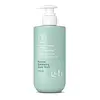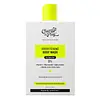What's inside
What's inside
 Key Ingredients
Key Ingredients

 Benefits
Benefits

 Concerns
Concerns

 Ingredients Side-by-side
Ingredients Side-by-side

Water
Skin ConditioningSodium C14-16 Olefin Sulfonate
CleansingCocamidopropyl Hydroxysultaine
CleansingAcrylates Copolymer
Sodium Benzoate
MaskingParfum
MaskingHydrogenated Castor Oil
EmollientCitric Acid
BufferingGlycerin
HumectantGlycereth-26
HumectantSodium Chloride
MaskingSodium Hydroxide
BufferingButylene Glycol
HumectantMalpighia Emarginata Fruit Extract
Skin ConditioningPolyquaternium-7
Tetrasodium EDTA
Hydrogenated Jojoba Oil
AbrasiveJuglans Regia Shell Powder
AbrasivePrunus Amygdalus Dulcis Shell Powder
AbrasivePrunus Armeniaca Seed Powder
AbrasiveDextrin
AbsorbentPhenoxyethanol
PreservativeLecithin
EmollientOlea Europaea Fruit Oil
MaskingPPG-12-Buteth-16
Skin ConditioningCeramide NP
Skin ConditioningAloe Barbadensis Leaf Juice
Skin ConditioningMaltodextrin
AbsorbentPhytosphingosine
Skin ConditioningBeta-Sitosterol
Emulsion StabilisingChlorphenesin
AntimicrobialHydrogenated Lecithin
EmulsifyingPerilla Ocymoides Leaf Extract
TonicBambusa Vulgaris Leaf Extract
Skin ConditioningTocopherol
AntioxidantPotassium Sorbate
PreservativeLimonene
PerfumingLinalool
PerfumingWater, Sodium C14-16 Olefin Sulfonate, Cocamidopropyl Hydroxysultaine, Acrylates Copolymer, Sodium Benzoate, Parfum, Hydrogenated Castor Oil, Citric Acid, Glycerin, Glycereth-26, Sodium Chloride, Sodium Hydroxide, Butylene Glycol, Malpighia Emarginata Fruit Extract, Polyquaternium-7, Tetrasodium EDTA, Hydrogenated Jojoba Oil, Juglans Regia Shell Powder, Prunus Amygdalus Dulcis Shell Powder, Prunus Armeniaca Seed Powder, Dextrin, Phenoxyethanol, Lecithin, Olea Europaea Fruit Oil, PPG-12-Buteth-16, Ceramide NP, Aloe Barbadensis Leaf Juice, Maltodextrin, Phytosphingosine, Beta-Sitosterol, Chlorphenesin, Hydrogenated Lecithin, Perilla Ocymoides Leaf Extract, Bambusa Vulgaris Leaf Extract, Tocopherol, Potassium Sorbate, Limonene, Linalool
Water
Skin ConditioningCocamidopropyl Betaine
CleansingSodium C14-16 Olefin Sulfonate
CleansingSorbitol
HumectantGlycerin
HumectantNiacinamide
SmoothingSodium Lauroyl Sarcosinate
CleansingPEG-150 Distearate
EmulsifyingGlycolic Acid
BufferingParfum
MaskingPEG-7 Glyceryl Cocoate
Emulsifying3-O-Ethyl Ascorbic Acid
Skin ConditioningAlpha-Arbutin
AntioxidantCeramide Ag
HumectantOryza Sativa Cera
Skin ConditioningPhospholipids
Skin ConditioningSphingolipids
EmollientGuar Hydroxypropyltrimonium Chloride
Skin ConditioningPropanediol
SolventMyrciaria Dubia Fruit Extract
Skin ConditioningPhenoxyethanol
PreservativeCI 19140
Cosmetic ColorantDisodium EDTA
Sodium Hydroxide
BufferingWater, Cocamidopropyl Betaine, Sodium C14-16 Olefin Sulfonate, Sorbitol, Glycerin, Niacinamide, Sodium Lauroyl Sarcosinate, PEG-150 Distearate, Glycolic Acid, Parfum, PEG-7 Glyceryl Cocoate, 3-O-Ethyl Ascorbic Acid, Alpha-Arbutin, Ceramide Ag, Oryza Sativa Cera, Phospholipids, Sphingolipids, Guar Hydroxypropyltrimonium Chloride, Propanediol, Myrciaria Dubia Fruit Extract, Phenoxyethanol, CI 19140, Disodium EDTA, Sodium Hydroxide
Ingredients Explained
These ingredients are found in both products.
Ingredients higher up in an ingredient list are typically present in a larger amount.
Glycerin is already naturally found in your skin. It helps moisturize and protect your skin.
A study from 2016 found glycerin to be more effective as a humectant than AHAs and hyaluronic acid.
As a humectant, it helps the skin stay hydrated by pulling moisture to your skin. The low molecular weight of glycerin allows it to pull moisture into the deeper layers of your skin.
Hydrated skin improves your skin barrier; Your skin barrier helps protect against irritants and bacteria.
Glycerin has also been found to have antimicrobial and antiviral properties. Due to these properties, glycerin is often used in wound and burn treatments.
In cosmetics, glycerin is usually derived from plants such as soybean or palm. However, it can also be sourced from animals, such as tallow or animal fat.
This ingredient is organic, colorless, odorless, and non-toxic.
Glycerin is the name for this ingredient in American English. British English uses Glycerol/Glycerine.
Learn more about GlycerinParfum is a catch-all term for an ingredient or more that is used to give a scent to products.
Also called "fragrance", this ingredient can be a blend of hundreds of chemicals or plant oils. This means every product with "fragrance" or "parfum" in the ingredients list is a different mixture.
For instance, Habanolide is a proprietary trade name for a specific aroma chemical. When used as a fragrance ingredient in cosmetics, most aroma chemicals fall under the broad labeling category of “FRAGRANCE” or “PARFUM” according to EU and US regulations.
The term 'parfum' or 'fragrance' is not regulated in many countries. In many cases, it is up to the brand to define this term.
For instance, many brands choose to label themselves as "fragrance-free" because they are not using synthetic fragrances. However, their products may still contain ingredients such as essential oils that are considered a fragrance by INCI standards.
One example is Calendula flower extract. Calendula is an essential oil that still imparts a scent or 'fragrance'.
Depending on the blend, the ingredients in the mixture can cause allergies and sensitivities on the skin. Some ingredients that are known EU allergens include linalool and citronellol.
Parfum can also be used to mask or cover an unpleasant scent.
The bottom line is: not all fragrances/parfum/ingredients are created equally. If you are worried about fragrances, we recommend taking a closer look at an ingredient. And of course, we always recommend speaking with a professional.
Learn more about ParfumPhenoxyethanol is a preservative that has germicide, antimicrobial, and aromatic properties. Studies show that phenoxyethanol can prevent microbial growth. By itself, it has a scent that is similar to that of a rose.
It's often used in formulations along with Caprylyl Glycol to preserve the shelf life of products.
Sodium C14-16 Olefin Sulfonate is a cleansing agent made from a mixture of long chain sulfonate salts. It can also help produce foam.
This ingredient may be drying. We recommend speaking with a professional if you have concerns.
Sodium Hydroxide is also known as lye or caustic soda. It is used to adjust the pH of products; many ingredients require a specific pH to be effective.
In small amounts, sodium hydroxide is considered safe to use. However, large amounts may cause chemical burns due to its high alkaline.
Your skin has a natural pH and acid mantle. This acid mantle helps prevent harmful bacteria from breaking through. The acid mantle also helps keep your skin hydrated.
"Alkaline" refers to a high pH level. A low pH level would be considered acidic.
Learn more about Sodium HydroxideWater. It's the most common cosmetic ingredient of all. You'll usually see it at the top of ingredient lists, meaning that it makes up the largest part of the product.
So why is it so popular? Water most often acts as a solvent - this means that it helps dissolve other ingredients into the formulation.
You'll also recognize water as that liquid we all need to stay alive. If you see this, drink a glass of water. Stay hydrated!
Learn more about Water